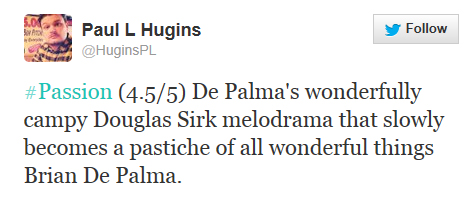
 Hello and welcome to the unofficial Brian De Palma website. Here is the latest news: |
|---|
E-mail
Geoffsongs@aol.com
-------------
Recent Headlines
a la Mod:
Listen to
Donaggio's full score
for Domino online
De Palma/Lehman
rapport at work
in Snakes
De Palma/Lehman
next novel is Terry
De Palma developing
Catch And Kill,
"a horror movie
based on real things
that have happened
in the news"
Supercut video
of De Palma's films
edited by Carl Rodrigue
Washington Post
review of Keesey book
-------------
Exclusive Passion
Interviews:
Brian De Palma
Karoline Herfurth
Leila Rozario
------------
------------
| « | November 2013 | » | ||||
| S | M | T | W | T | F | S |
| 1 | 2 | |||||
| 3 | 4 | 5 | 6 | 7 | 8 | 9 |
| 10 | 11 | 12 | 13 | 14 | 15 | 16 |
| 17 | 18 | 19 | 20 | 21 | 22 | 23 |
| 24 | 25 | 26 | 27 | 28 | 29 | 30 |
De Palma interviewed
in Paris 2002
De Palma discusses
The Black Dahlia 2006

Enthusiasms...
Alfred Hitchcock
The Master Of Suspense
Sergio Leone
and the Infield
Fly Rule
The Filmmaker Who
Came In From The Cold
Jim Emerson on
Greetings & Hi, Mom!
Scarface: Make Way
For The Bad Guy
Deborah Shelton
Official Web Site
Welcome to the
Offices of Death Records
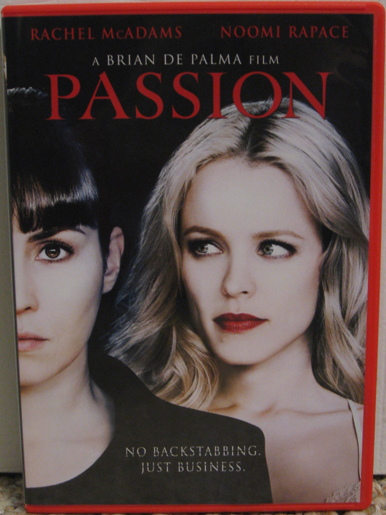 If you went DVD shopping today, Brian De Palma's Passion probably stood out amongst the other new releases, as the cover art was framed by its red plastic shell. Even the Blu-Ray edition is red instead of the usual blue. And to accentuate the lipstick color, the robe worn by Rachel McAdams in the film has been altered for the back cover (and the disc label-- see below) from green to red. Well, that's one way to help the product stand out amongst its competition.
If you went DVD shopping today, Brian De Palma's Passion probably stood out amongst the other new releases, as the cover art was framed by its red plastic shell. Even the Blu-Ray edition is red instead of the usual blue. And to accentuate the lipstick color, the robe worn by Rachel McAdams in the film has been altered for the back cover (and the disc label-- see below) from green to red. Well, that's one way to help the product stand out amongst its competition.
 Brian De Palma's Passion comes out on DVD and Blu-Ray in the U.S. this Tuesday, November 5th. But people in Cleveland can see the film sooner when the Cinematheque at the Cleveland Institute of Art screens De Palma's latest from Blu-Ray, in what the Cinematheque website calls the "Cleveland premiere." Passion screens Friday November 1st at 9:30pm, and Saturday November 2nd at 7:30pm.
Brian De Palma's Passion comes out on DVD and Blu-Ray in the U.S. this Tuesday, November 5th. But people in Cleveland can see the film sooner when the Cinematheque at the Cleveland Institute of Art screens De Palma's latest from Blu-Ray, in what the Cinematheque website calls the "Cleveland premiere." Passion screens Friday November 1st at 9:30pm, and Saturday November 2nd at 7:30pm.
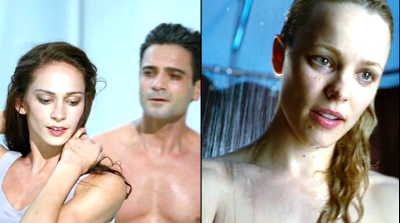 John Kenneth Muir posted his review of Brian De Palma's Passion today, stating that De Palma "corkscrews" Alain Corneau's Love Crime, "and in the process creates a work of art totally of his own design, one that focuses intently on the ideas of narcissism and voyeurism in the Web 2.0 Age." SPOILERS - Muir further writes that "Passion is a thriller about blackmail, extortion, and one-upmanship in the epoch of the 'Send Button,' when one flick of a finger can ruin a career, destroy a life, or send someone to jail for murder. Specifically, Passion is veritably obsessed with the vindictive release of private or guarded information into the public arena, and the catastrophic fall-out and public humiliation that occurs in its aftermath. It is this public humiliation, and fear of such humiliation, that leads to the film’s double murders."
John Kenneth Muir posted his review of Brian De Palma's Passion today, stating that De Palma "corkscrews" Alain Corneau's Love Crime, "and in the process creates a work of art totally of his own design, one that focuses intently on the ideas of narcissism and voyeurism in the Web 2.0 Age." SPOILERS - Muir further writes that "Passion is a thriller about blackmail, extortion, and one-upmanship in the epoch of the 'Send Button,' when one flick of a finger can ruin a career, destroy a life, or send someone to jail for murder. Specifically, Passion is veritably obsessed with the vindictive release of private or guarded information into the public arena, and the catastrophic fall-out and public humiliation that occurs in its aftermath. It is this public humiliation, and fear of such humiliation, that leads to the film’s double murders."Early in the film, she recounts to Isabelle a story about her twin-sister, Clarissa. Specifically Clarissa was killed because of Christine’s actions. Christine was riding a bike when she was distracted by the bike’s mirror, and an oncoming truck hit the girls. Only Christine survived.
"I just wanted to see myself…and I saw my reflection," Christine reports of the tragedy.
Another scene reveals that Christine keeps a creepy white mask -- one that is molded to resemble her facial features -- because, again, she wants to "see" herself.
And in the absence of her twin, that is not always easy.
Accordingly, Christine goes through the film and through her life attempting to re-make others in the image she wants to see: her own. In particular, this means that Christine creates "users" and "manipulators" like herself, and indeed, that’s the journey Isabelle takes in the film. She goes from being a relatively normal person to a competitive player, to a monster who becomes Christine’s "double" and equal. By film’s end, she has been re-fashioned in Christine’s desired image, but she is not able to handle it, perhaps because she possesses the conscience Christine abundantly lacks."
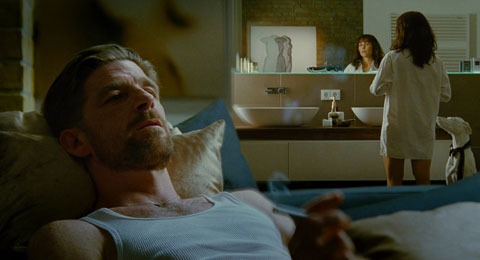
However, since going into self-imposed exile from the Hollywood studio system following Mission To Mars (2000), De Palma has been working on smaller scale independent productions, many of them based in Europe. A director of his stature no longer has anything to prove, and producers approach him knowing his previous work and, therefore, his quirks and capabilities. Thanks to this freedom, De Palma has been indulging in more playful and challenging cinematic techniques. The 'alternative universe' scenario of Femme Fatale (2002) is a good example of this, where a large section of the narrative is in fact the lead character's premonition, warning her where life will lead if she makes the wrong decision. With Passion, he returns to the initial dream-within-dream concept of Raising Cain and this time goes through with it, seemingly unconcerned if the audience sometimes gets lost. The constant twists, red herrings and false endings are disorientating on initial viewing, but subsequent viewings reveal a precise logic behind these overlapping elements. For example, on revisiting the film it becomes noticeable that images in the dream sequences are marked out by a much heavier blue tint than is used in the remainder of the film. It is clear that De Palma is having fun with the form, and he saves a final laugh for the very end: the screen cuts to black and ‘The End' appears in simple white lettering before the closing credits roll. This title playfully anticipates a collective sigh of relief from the audience: there will be no more bewildering twists and turns. It's over, the viewer can finally relax.
 SPOILERS - In Brian De Palma's adaptation of James Ellroy's The Black Dahlia, there is a scene in which Bucky tells Kay that Lee's tragic past with his sister explains a few things, to which she shoots back at him, "No it doesn't." A similar tragic story of a sister in the past functions to "explain a few things" to Isabelle in De Palma's latest film, Passion, but the viewer, and eventually, Isabelle, are left wondering if any of it is true or not.
SPOILERS - In Brian De Palma's adaptation of James Ellroy's The Black Dahlia, there is a scene in which Bucky tells Kay that Lee's tragic past with his sister explains a few things, to which she shoots back at him, "No it doesn't." A similar tragic story of a sister in the past functions to "explain a few things" to Isabelle in De Palma's latest film, Passion, but the viewer, and eventually, Isabelle, are left wondering if any of it is true or not.1. After claiming she's off to "grab a taxi", Isabelle first walks over to Dirk, and Christine spots them make out behind her back [Perhaps "making out" is a bit strong-- would they do that knowing Christine might possibly catch them in the act? It would be enough for Christine to merely spot a glimpse of Dirk in the area where Isabelle is headed to put two and two together.]
2. Genuinely hurt, she gazes after the couple walking up the stairs towards the exit [Or perhaps the first frame shows her watching Isabelle leave, while the second frame shows her spotting Dirk just managing to head toward the exit at the top of the stairs, as Isabelle is still climbing]
3. Being who she is, Christine quickly regains her composure
4. …and ominously plots revenge!
Patrick's fourth frame reading would perhaps indicate why these shots may have been cut from the final film. They might make it too obvious to the viewer when, the next morning, Christine tells Isabelle the story of her sister. As it stands, Christine's attempt to bond with Isabelle in this scene seems perhaps genuine. But had it come after the deleted shots above from the Bode Museum, the viewer might immediately sense that Christine is lying and plotting revenge. In this same scene, of course, Christine turns on Dirk, as well, and in between, makes it (almost confusingly) clear that she is aware of something going on between Dirk and Isabelle.
However, it has always seemed to me that in De Palma's film, Christine is more hurt by Isabelle's leap-frogging taking away of her plans for New York than for any indiscretions she may have had with Dirk. By leaving out the shots above, the viewer is left to speculate whether or not it was always part of Christine's weird scheming to put Isabelle and Dirk together-- and who knows, maybe even with the deleted shots above, maybe she had, in fact, meant for the two of them to have a fling. Going back to The Black Dahlia, think about the New Year's eve party, in which Lee watches Bucky and Kay kiss each other, and De Palma's camera focuses on Lee watching them, his feelings on the matter difficult for the viewer to discern. Has Lee been plotting for these two to be together? Has Christine been doing the same? De Palma sets up the long looks from Christine in Passion's opening minutes, as Christine watches Isabelle leave her house after wrapping Dirk's scarf around her neck. Is she already thinking of a Dirk offering this early on? It might explain a few things, but no it doesn't.
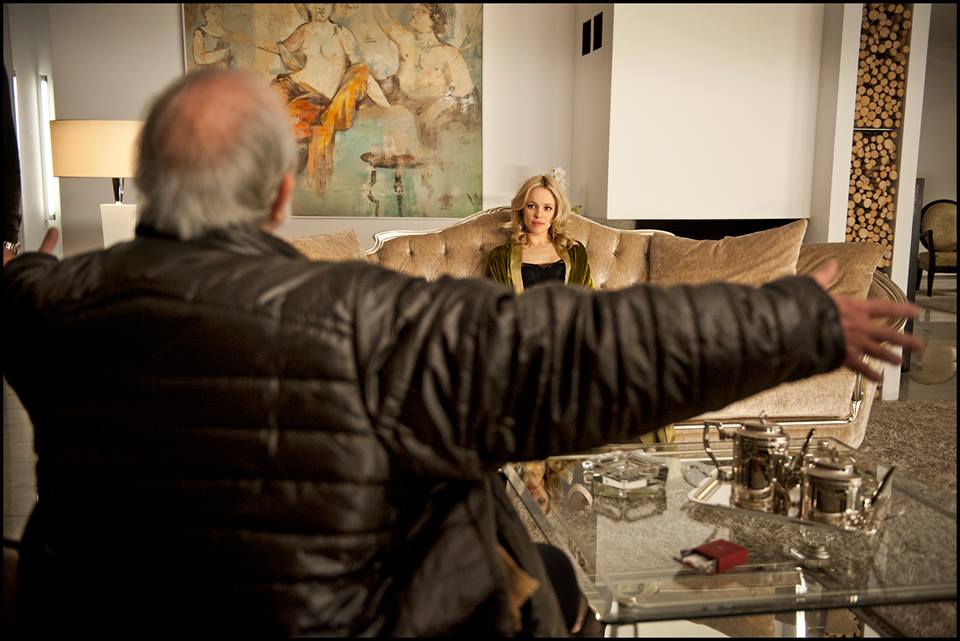
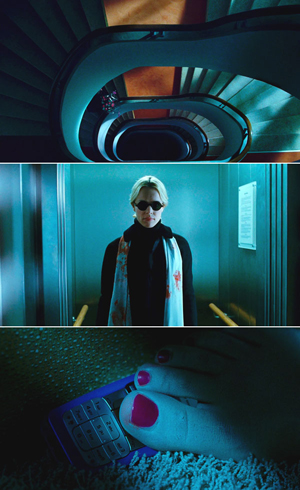 The new issue of the cinema journal L O L A went live yesterday, and it includes a dossier of four essays on the films of Brian De Palma, leading with a beautiful take on Passion (titled "To the Passion") by Cristina Álvarez López and Adrian Martin. Here's the inro to that article:
The new issue of the cinema journal L O L A went live yesterday, and it includes a dossier of four essays on the films of Brian De Palma, leading with a beautiful take on Passion (titled "To the Passion") by Cristina Álvarez López and Adrian Martin. Here's the inro to that article:As with all the best De Palma films, watching Passion (2012) should remind us of a contrary truth: when it comes to the exhilarating thrill, the wallop of cinema that his work gives us, it’s always the first time. Of course, there are broadly similar games with devious plots, POVs, split-screens, identity switches/disguises – play with the five senses and with every kind of media screen – in at least a dozen of his previous movies. But we were not thinking of Dressed to Kill (1980) or Raising Cain (1992) or Femme Fatale (2002) while we were absorbed in Passion: that type of unravelling always comes later. Nor were we trying to construct a hyper-intellectual contraption (in the manner of a recent woeful book) to ‘account for’ or explain away the intense, complicated, visceral pleasure we derive from his films.
When one of the main characters dies at the precise mid-way point, when the dreams and the dreams-within-dreams begin to unfold, when the camera tilts calamitously in a room or tracks in slowly to a face, when the plot lines pile up and converge on a single, catastrophic point … when these events, great and small, happen, we are not immediately flipping through the De Palma back catalogue; we are in the moment, the screen moment. Something that shakes us, that resonates, is happening there – we definitely know this by the final frames – and it is our task as critics to figure out what forces are involved, what has been deftly drawn into the fray. This task has nothing to do with taking the old Pauline Kael line that De Palma’s cinema is all about (and only about) energy, ‘pop vitalism’ and all-American vulgarity: such so-called ‘defence of trash’ too often clogs up the response-pores of even De Palma’s most public devotees.
Passion is not (as we are hearing a lot at the moment) a wilfully ‘ridiculous’ film (it is especially depressing to hear this said as praise!) or a self-consciously trashy one: these kinds of responses always tell more about the person uttering it than about the filmmaker in question. De Palma has gotten to a position in his career that is a little reminiscent of Samuel Fuller in his early-to-mid 1960s prime: his films mix vigorous, generic structures with sincere samplings of culture high and low (from viral YouTube videos to Jerome Robbins’ ballet choreography of Afternoon of a Faun); they meld expressionistic and melodramatic aesthetic patterns with a cold, hard edge of social criticism. And none of his films are so stringently, steely cold as Passion.
ALAIN BERGALA ON 'OBSESSION'
In "Time Denied: An Apotheosis of the Imaginary", Alain Bergala looks at the assumption of the image in De Palma's Obsession. "The major difference between Scottie in Vertigo and Michael in Obsession, states Bergala, "is that Michael is in a deeper sleep than Scottie. He wants to believe in the reality of his waking dream with a deep and naïve conviction. The whole film is an obstinate refusal to wake up, to leave the bliss of the imaginary. He rushes like a bull towards the first illusion that is offered to him – this woman who is the reincarnation of his dead wife."
In one section of the essay, Bergala discusses how De Palma's camera movements in Obsession follow the slowness of Stanley Kubrick's in Barry Lyndon: "A slow zoom-in draws the viewer into the bottomless pit of the imaginary. In Samuel Blumenfeld and Laurent Vachaud’s book of interviews, De Palma talks about the Kubrick of Barry Lyndon (1975), of the slowness of that film, of ‘the impression that everything was happening in slow motion: the movements of the camera and the actors. You really got the feeling of perceiving time in a different way, as if we had actually returned to the 18th century’. In the same interview, he claims, regarding the zooms that are used systematically in that film, that he would be bored, personally, to repeat the same technique throughout an entire film. And yet this is what he does tirelessly in Obsession, where he multiplies the long, fluid shots of the undulating imaginary."
"RESPONSIVE EYES AND CROSSING LINES"
In the fourth essay, "Responsive Eyes and Crossing Lines: Forty Years of Looking and Reading", Helen Grace presents an episodic look at her experience within the landscape of feminism over the years. In episode 3, she recalls the protests against De Palma's Dressed To Kill while in London in 1980:
"We saw Dressed to Kill, fearing that we would be shocked and horrified, and that we might come out convinced that screen terrorism was necessary. Instead, we watched a film which seemed to say more about masculine anxiety than about the fears that women were expressing in relation to the film. We kept waiting for the horror – and when it came, we enjoyed it. We wondered if we had seen the same film that people had been complaining about, so we went to one of the street meetings to discuss our problems. We found out that, in fact, none of the women had seen the film at all, and they did not want to hear our opinions about it.
"And this turned out to be a general feature in every situation in which a ‘citizen censorship’ movement called for the boycott of a film to which one group or another took offence, whether it was feminists and gays objecting to a Brian De Palma film, or Christians protesting the screening of Jean-Luc Godard’s Hail Mary (1985) five or six years later. It was exactly this period of the ‘80s when some strands of feminism seemed indistinguishable from right-wing Christian extremism in the anti-democratic gestures of, for example the Dworkin-MacKinnon Anti-Pornography Civil Rights Ordinance (1983) – which, fortunately, did not succeed. In any case, it was anti-pornography activism that first drew my attention to Dressed to Kill. And that is how I came to be a De Palma fan."